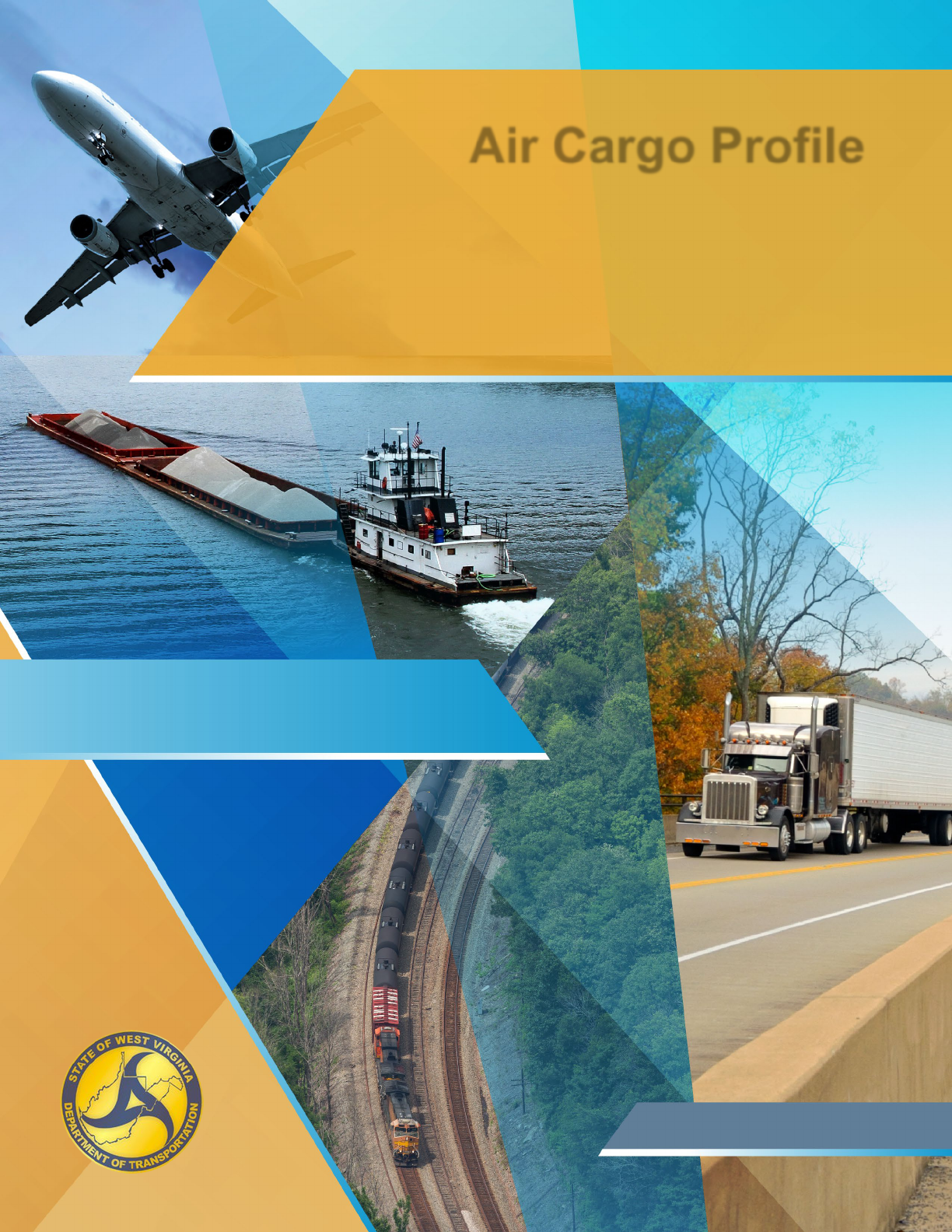
WEST VIRGINIA STATE
FREIGHT PLAN
Air Cargo Profile
November 2023

Tech Memo
West Virginia State Freight Plan
Air Cargo Profile
prepared by
Cambridge Systematics, Inc.
with
Mott MacDonald
date
November 2023

Air Cargo Profile
West Virginia Department of Transportation
i
TABLE OF CONTENTS
1.0 Introduction ............................................................................................................................................ 5
1.1 Overview of the Plan ...................................................................................................................... 5
1.2 West Virginia Freight Transportation Vision and Goals ................................................................. 6
1.3 Aviation Profile Overview ............................................................................................................... 6
2.0 Air Cargo Network Inventory ................................................................................................................ 7
2.1 Overview of Cargo Airports in West Virginia.................................................................................. 7
2.1.1 Airport Profiles ................................................................................................................ 10
2.2 West Virginia Air Cargo Service Classification Types ................................................................. 14
2.2.1 Dedicated Air Cargo........................................................................................................ 14
2.2.2 Integrator ......................................................................................................................... 14
2.2.3 Belly Cargo ..................................................................................................................... 15
2.2.4 U.S. Mail ......................................................................................................................... 16
2.3 Other Air Cargo Gateways ........................................................................................................... 16
3.0 Air Cargo Demand ................................................................................................................................ 18
3.1 Total Air Freight Demand ............................................................................................................. 18
3.2 Future of Aviation Trends ............................................................................................................ 21
3.2.1 Aircraft and Airport Technology ...................................................................................... 22
3.2.2 Economic Trends ............................................................................................................ 22
3.2.3 Advanced Air Mobility, Urban Air Mobility, and Unmanned Aircraft Systems ................. 23
3.2.4 Aviation Safety and Security ........................................................................................... 23
3.2.5 Response to the COVID-19 Pandemic ........................................................................... 24
4.0 Condition and Performance ................................................................................................................ 25
4.1 Road Network Access.................................................................................................................. 25
4.1.1 BKW ................................................................................................................................ 25
4.1.2 CKB ................................................................................................................................. 26
4.1.3 LWB ................................................................................................................................ 27
4.1.4 CRW ............................................................................................................................... 28
4.1.5 HTS ................................................................................................................................. 29
4.2 Capacity ....................................................................................................................................... 30
4.3 Conclusions ................................................................................................................................. 30

Air Cargo Profile
West Virginia Department of Transportation
ii

Air Cargo Profile
West Virginia Department of Transportation
iii
LIST OF TABLES
Table 2-1 West Virginia Airport Key Statistics .......................................................................................... 8
Table 2-2: Other West Virginia Airports ................................................................................................... 13

Air Cargo Profile
West Virginia Department of Transportation
iv
LIST OF FIGURES
Figure 1-1 West Virginia State Freight Plan Technical Activities ............................................................... 5
Figure 2-1 West Virginia Major Airports ..................................................................................................... 7
Figure 2-2 Beckley Raleigh County Memorial Airport (BKW) .................................................................. 10
Figure 2-3 Greenbrier Valley Airport (LWB) ............................................................................................. 11
Figure 2-4 Huntington Tri-State Airport (HTS) ......................................................................................... 11
Figure 2-5 North Central West Virginia Airport (CKB).............................................................................. 12
Figure 2-6 West Virginia International Yeager Airport (CRW) ................................................................. 13
Figure 2-7 Amazon Freight Coverage Map .............................................................................................. 15
Figure 2-8 Freight Airports near West Virginia ......................................................................................... 17
Figure 3-1 Share of Two-Way Freight Transport Modes by Tonnage in West Virginia, 2017
Projected through 2050 .......................................................................................................... 19
Figure 3-2 Two-Way Air Freight Tonnage in West Virginia, 2017 through 2050 ..................................... 19
Figure 3-3 Air Freight Commodities to and from West Virginia 2017 through 2050 ................................ 20
Figure 3-4 Ultimate Origins and Destinations of Air Freight to and from West Virginia 2017
through 2050 ........................................................................................................................... 20
Figure 3-5 Domestic Origins and Destinations (U.S. States) of Air Freight to and from West
Virginia 2017 through 2050 .................................................................................................... 21
Figure 4-1 BKW Airport ............................................................................................................................ 26
Figure 4-2 CKB Airport ............................................................................................................................. 27
Figure 4-3 LWB Airport ............................................................................................................................ 28
Figure 4-4 CRW Airport ............................................................................................................................ 29
Figure 4-5 HKS Airport ............................................................................................................................. 30

Air Cargo Profile
West Virginia Department of Transportation
5
1.0 INTRODUCTION
1.1 Overview of the Plan
In 2022, the West Virginia Department of Transportation (WVDOT) began its update of the West Virginia
State Freight Plan. This Plan will fulfill federal requirements for state freight planning, identify opportunities
for West Virginia to invest in its freight system, and position WVDOT to take full advantage of federal formula
and discretionary funding programs for freight transportation investments. Additionally, the Plan will detail
freight activity, needs, and priorities, and support WVDOT in meeting the agency’s overall goals as well as
those of this Plan.
The purpose of this Air Cargo Profile is to identify West Virginia’s existing air cargo assets and air cargo
demand and assess their performance and condition. Documenting existing challenges helps identify
strategies and solutions to aid the state going forward and is one of many complementary technical activities
that will be developed as part of this planning process. The overall process is shown in Figure 1-1, and will
be developed in conjunction with a robust stakeholder engagement effort that will support the data driven
aspects of this Plan.
Figure 1-1 West Virginia State Freight Plan Technical Activities
Review and
Coordination
Review of
Existing Plans
Data Needs
Assessment
State of the
System
Modal
Profiles
Commodity Flow
Profile
Economic and
Industry Trends
Strategic
Direction
Freight Vision,
Goals and
Objectives
Freight Needs
Assessment
Environmental
and Equity
Impacts
Performance
Measures
Priorities and
Implementation
Freight
Strategies
Freight
Investment Plan
Implementation
Plan
Stakeholder Engagement

Air Cargo Profile
West Virginia Department of Transportation
6
1.2 West Virginia Freight Transportation Vision and Goals
The vision of the West Virginia State Freight Plan is as follows:
WVDOT will achieve this vision through the following goals:
• System Condition, Efficiency, and Fiscal Sustainability: Maintain multimodal and intermodal freight
transportation infrastructure in a state of good repair and manage lifecycle costs; efficiently deliver
projects, programs and services supporting goods movement; and work to maintain existing funding
mechanisms while exploring new alternative and sustainable funding mechanisms.
• Safety and Security for All Users: Reduce transportation fatalities and serious injuries involving freight
vehicles, improve the safety and security of drivers, cargo, and intermodal facilities, and improve the
resilience of the freight system particularly to severe weather events and other disruptions.
• Economic Vitality: Strengthen the ability of communities and industries to access national and
international trade markets, retain and grow existing WV statewide and regional economic focus sectors,
and support regional economic development that will diversity WV's economy.
• Multimodal Mobility, Reliability, and Accessibility: Facilitate freight mobility and connections for
on-demand and reliable goods delivery across all West Virginia communities, including critical services
such as health care and emergency management.
• Livable and Healthy Communities: Create freight transportation systems that operate efficiently and
cleanly, protect the natural environment and maintain access for residents and visitors to experience
WV's natural and cultural destinations.
1.3 Aviation Profile Overview
This technical memorandum is organized as follows:
• Section 2.0 – Air Cargo Network Inventory
• Section 3.0 – Air Cargo Demand
• Section 4.0 – Condition and Performance
THE WEST VIRGINIA DEPARTMENT OF TRANSPORTATION'S MISSION IS TO RESPONSIBLY
PROVIDE A SAFE, EFFICIENT AND RELIABLE TRANSPORTATION SYSTEM THAT SUPPORTS
ECONOMIC OPPORTUNITY AND QUALITY OF LIFE.
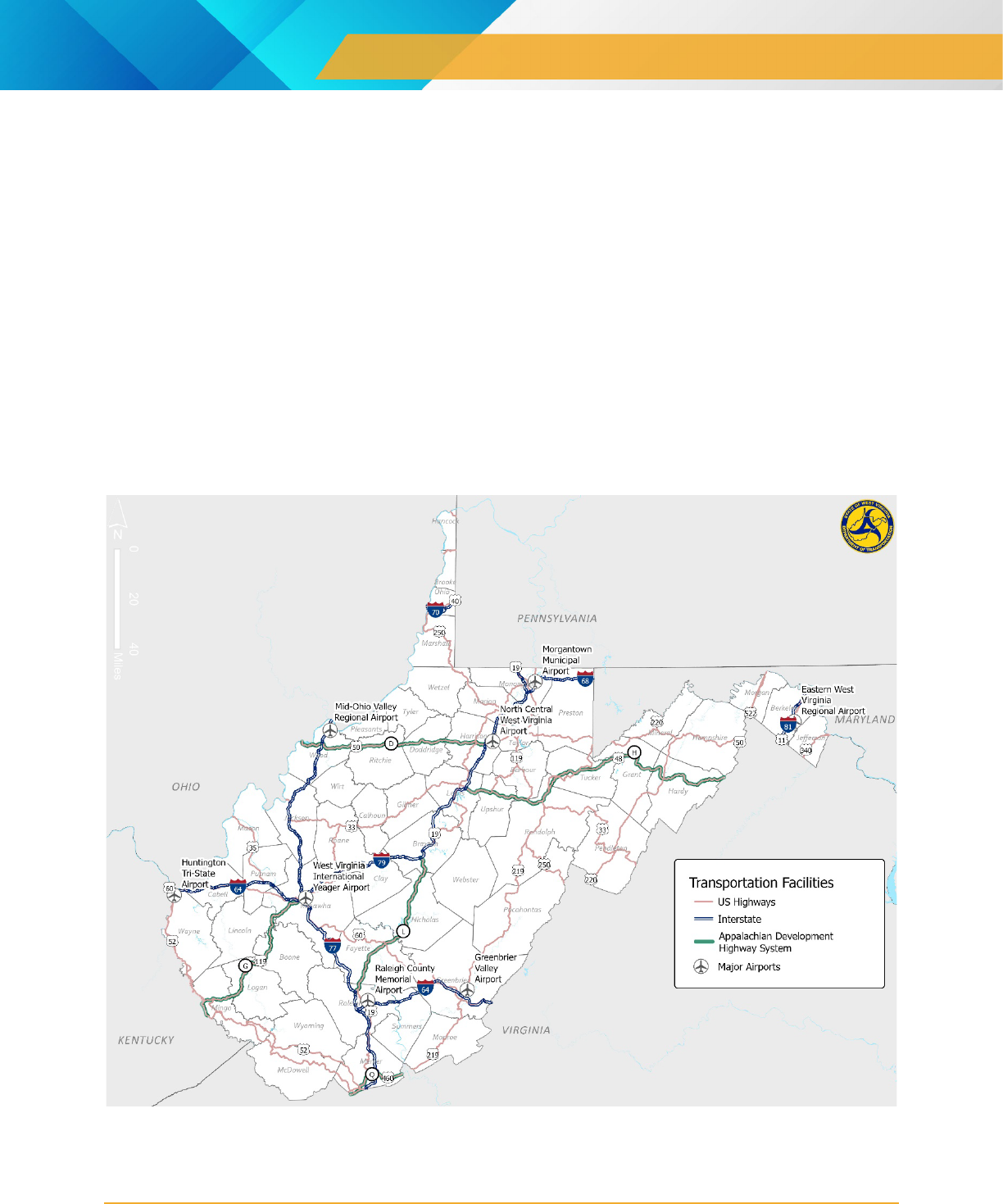
Air Cargo Profile
West Virginia Department of Transportation
7
2.0 AIR CARGO NETWORK INVENTORY
2.1 Overview of Cargo Airports in West Virginia
Aviation is critical to West Virginia’s economy and its residents’ way of life. While passenger traffic is often
the most visible part of a state’s aviation system, airports also connect air cargo markets, allow for expedited
mail and package delivery, and support real-time freight solutions such as rush order shipments of critical
equipment or parts. Airport passenger service also plays a role in air cargo, as scheduled airline services
often accommodate small amounts of freight in what is referred to as "belly cargo.”
There are 23 airports in the state of West Virginia. Five airports handled air cargo between 2016 to 2021,
according to the Bureau of Transportation Statistics (BTS) T-100 data (see Figure 2-1): Huntingdon Tri-State
International Airport (HTS); Beckley Raleigh County Memorial Airport (BKW); North Central West Virginia
Airport (CKB); Greenbrier Valley Airport (LWB); and West Virginia International Yeager Airport (CRW).
Figure 2-1 West Virginia Major Airports
Source: West Virginia GIS Data

Air Cargo Profile
West Virginia Department of Transportation
8
When compared to international or national gateways, the volume of traffic, both passenger and freight, at
West Virginia airports is proportionately small with many of the airports being designated either a Small or
Non-Hub facility by the U.S. Federal Aviation Administration (FAA)
1
. Air cargo moving through West
Virginia’s airports is primarily transported by small cargo aircraft and/or as belly cargo. Table 2-1 West
Virginia Airport Key Statistics summarize the volumes of air freight and passengers, as well as the number of
passenger and air cargo carriers at each of the five airports.
Table 2-1 West Virginia Airport Key Statistics
2016
2017
2018
2019
2020
2021
Comments
Beckley
Raleigh
County
Memorial
Airport
(BKW)
Total
enplaned
air freight
tonnage
143
169
157
160
133
148
The passenger
growth at BKW is
likely due to new
service added by
Contour Airlines,
who transported 21
outbound
passengers in
2017, 839 in 2018,
8,669 in 2019,
5,002 in 2020, and
9,987 in 2021.
Total
enplaned
passengers
2,251
1,539
2,468
8,669
5,002
9,987
Total
deplaned
air freight
tonnage
0
0
0
0.6
0
0
Total
deplaned
passengers
1,815
1,517
1,927
4,993
3,023
7,254
Greenbrier
Valley
Airport
(LWB)
Total
enplaned
air freight
tonnage
9
15
5
0
7
6
Generally, all freight
activity for the
airport is driven by
United Airlines. In
2018, United
decreased service
at LWB and
SkyWest operated
on their behalf in
2019.
Total
enplaned
passengers
5,285
5,448
10,035
12,727
3,986
10,905
Total
deplaned
air freight
tonnage
7
14
4
0
7
6
Total
deplaned
passengers
5,758
5,421
10,566
12,776
3,878
11,159
Huntington
Tri-State
International
Airport (HTS)
Total
enplaned
air freight
tonnage
4,274
4,254
4,175
3,899
3,802
3,542
HTS saw a
decrease in
passenger and
1
Airport Categories | Federal Aviation Administration (faa.gov)

Air Cargo Profile
West Virginia Department of Transportation
9
2016
2017
2018
2019
2020
2021
Comments
Total
enplaned
passengers
98,480
103,718
101,649
108,513
58,577
94,970
freight activity in
2020 due to
COVID-19, which
restabilized in 2021.
Total
deplaned
air freight
tonnage
7,037
6,801
7,101
9,015
7,215
7,058
Total
deplaned
passengers
95,791
100,887
99,088
106,847
57,747
93,532
North
Central
West Virginia
Airport
(CKB)
Total
enplaned
air freight
tonnage
15
18
22
18
16
15
CKB saw a
decrease in
passenger activity
in 2020 due to
COVID-19, which
restabilized in 2021.
Total
enplaned
passengers
25,967
25,104
36,915
41,791
18,468
37,164
Total
deplaned
air freight
tonnage
16
19
21
19
12
16
Total
deplaned
passengers
25,062
24,702
36,245
41,288
18,586
36,473
West Virginia
International
Yeager
Airport
(CRW)
Total
enplaned
air freight
tonnage
95
20
17
72
8
5
CRW saw a
decrease in
enplaned air freight
tonnage in 2017 –
USA Jet Airlines
handled 43 tons of
freight in 2016 and
did not operate in
CRW in 2017 or
2018.
CRW saw a
threefold increase
in enplaned
tonnage in 2019
likely due to the
return of USA Jet
Airlines.
Total
enplaned
passengers
213,408
202,777
216,364
226,104
91,935
148,879
Total
deplaned
air freight
tonnage
311
301
334
281
297
219
Total
deplaned
passengers
212,275
202,633
214,919
223,585
90,855
147,602
Source: Bureau of Transportation statistics, T-100 Market (All Carriers)
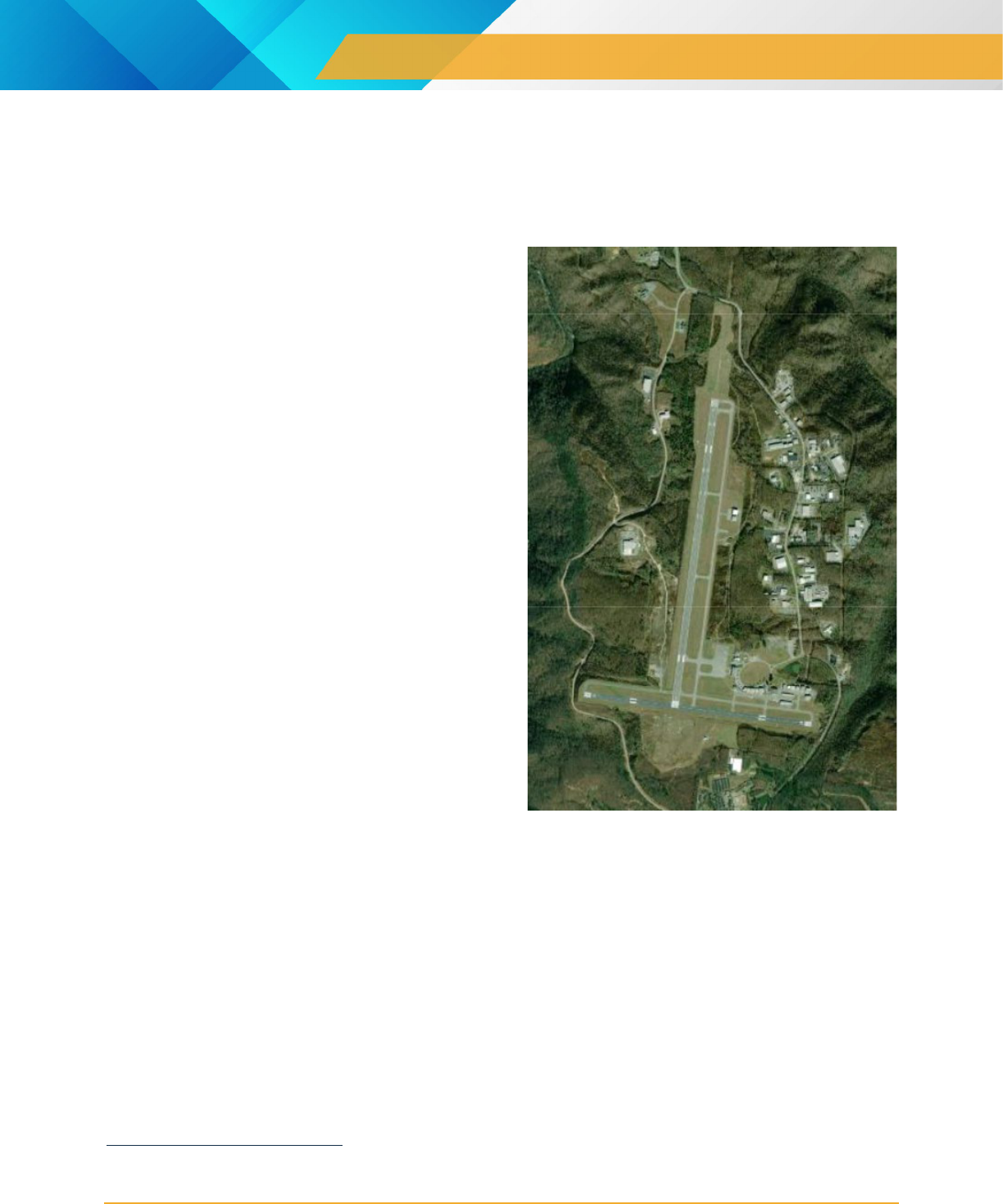
Air Cargo Profile
West Virginia Department of Transportation
10
2.1.1 Airport Profiles
Beckley Raleigh County Memorial Airport
(BKW)
BKW is located approximately four miles east of
Beckley, West Virginia. The airport is owned and
operated by the Raleigh County Airport Authority and
covers an area of 1,433 acres with two perpendicular
runways, RWY1/19 (6,750 feet) running north-south
and RWY10/28 (5,001 feet) running east-west. Major
highways are located close, and connect the airport to
the rest of the state, including I-64 and north-south
running U.S. 19 from Erie, Pa. to Memphis, Fla. In close
proximity running from Cleveland, Ohio to Columbia,
S.C. is I-77.
The airport processed 148 tons of enplaned freight and
no deplaned freight in 2021,
2
with FedEx as the only
operator (FedEx services at BKW are operated by
Mountain Air Cargo, with ATR-42 and ATR-72
equipment). The FedEx Ship Center (which offers
shipping and postal services) is located on the eastern
side of the airport next to RWY1/19. In recent years,
BKW was awarded grants from the FAA. In October
2021, $2.9 million was awarded to go towards taxiway
construction works and in March 2023, $1.0 million was
awarded to expand the passenger terminal to
accommodate a 50-seat hold room, accessible rest
rooms, and several other sustainable design concepts
to enhance energy efficiency.
Passenger services at the airport are limited, with Contour Airlines offering flights as public charters on
Embraer 135 and Embraer 145 aircraft.
2
Bureau of Transportation Statistics, T-100 data
Figure
2-2 Beckley Raleigh County Memorial
Airport (BKW)
Source: Esri ArcGIS
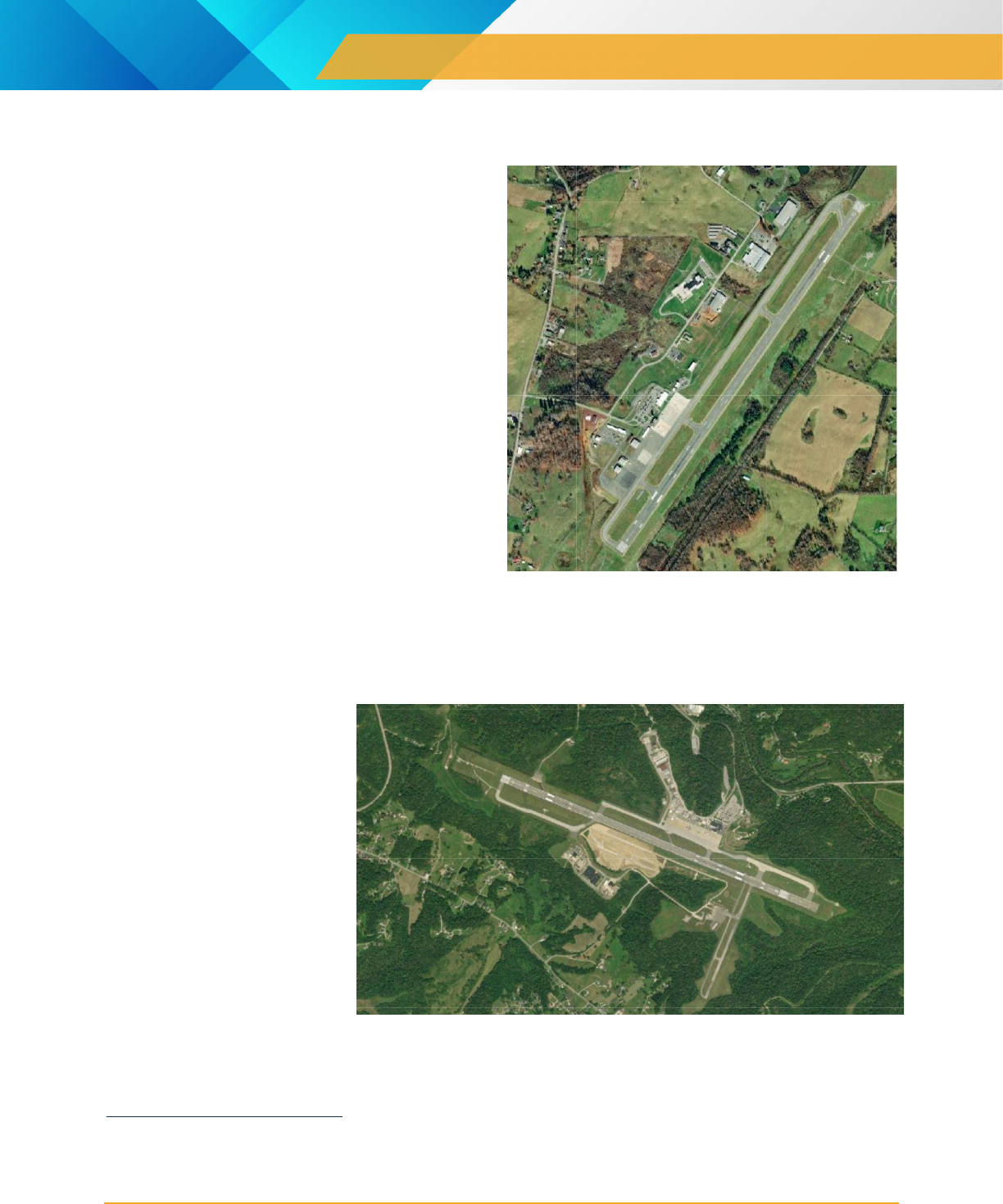
Air Cargo Profile
West Virginia Department of Transportation
11
Greenbrier Valley Airport (LWB)
LWB is located approximately four miles northeast of
Lewisburg, West Virginia. It has one 7,003-foot
runway and occupies 472 acres of land. The airport
is connected with U.S. 219 intersecting with I-64
south of the airport. In 2021, only six tons of
enplaned air freight and six tons of deplaned air
freight was processed at LWB with United Airlines as
the sole operator utilizing belly cargo hold of
passenger aircraft.
3
The airport handled 10,905 departing passengers
during 2021.
4
United Airlines stopped serving the
airport during 2022. In December 2022, Contour
Airlines launched a service providing 12 trips per
week to Charlotte, using Embraer 135 and Embraer
145 aircraft.
LWB was awarded a $4.6 million FAA grant in
November 2022 to construct and renovate buildings
to house and maintain snow removal equipment.
Huntington Tri-State International Airport (HTS)
HTS is located approximately
six miles southwest of
Huntington, West Virginia. The
airport serves three states,
given its location near West
Virginia’s borders with Kentucky
and Ohio. The airport is owned
and operated by the Tri-State
Airport Authority, which includes
members from West Virginia,
Kentucky, and Ohio, and covers
an area of 1,300 acres with a
single 7,017-foot runway. The
airport is located near several
major highways, including U.S.
52 which runs from Portal, North
Dakota to Charleston, South
Carolina, as well as I-64 which runs east-west from Chesapeake, Virginia to Wentzville, Missouri.
3
Bureau of Transportation Statistics, T-100 data
4
Bureau of Transportation Statistics, T-100 data
Figure
2-3 Greenbrier Valley Airport (LWB)
Source: Esri ArcGIS
Figure
2-4 Huntington Tri-State Airport (HTS)
Source: Esri ArcGIS
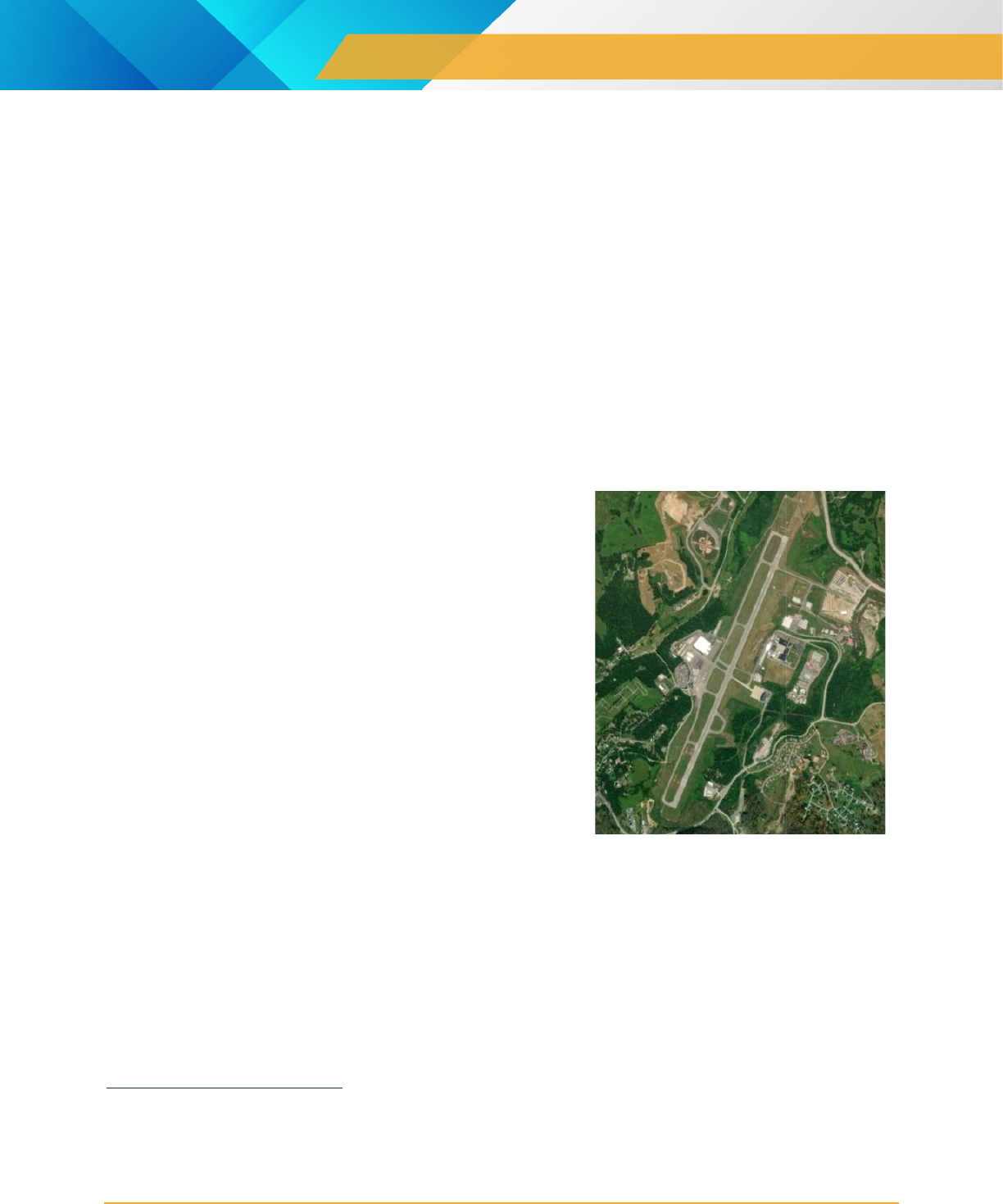
Air Cargo Profile
West Virginia Department of Transportation
12
In 2021, HTS handled 3,542 tons of enplaned freight and 7,058 tons of deplaned freight. FedEx is the main
operator, handling 3,507 tons of enplaned freight, (approximately 99% of all enplaned freight at this airport).
5
The other two airlines providing freight services are Atlas and Piedmont Airlines (operating on behalf of
American Airlines). FedEx operates the only Boeing 757 hub in West Virginia at HTS,
6
with its ship center
located at the northern side of the airport. This airport is the largest in the state in terms of enplaned freight in
2021.
HTS handled 95,000 departing passengers in 2021. Passenger services are operated by American Airlines
(to Charlotte, primarily on Embraer E-145s), and Allegiant Air to destinations in South Carolina (Myrtle
Beach) and Florida (Destin-Fort Walton Beach, Orlando-Sanford, Punta Gorda, and St Petersburg) using
A319 and A320 equipment.
North Central West Virginia Airport (CKB)
CKB is situated approximately six miles east of Clarksburg, West
Virginia. The airport has an area of 434 acres and operates with
a single runway of 7,800 feet. The major highway connecting the
airport to Clarksburg and other parts of the state is U.S. 50.
Running from north to south on the western side of the airport, I-
79 connects Erie, Pennsylvania in the north to Charleston, West
Virginia in the south. United Airlines was the only operator
providing air freight services at CKB in 2021, which it does in the
hold of passenger aircraft. The airport processed 15 tons of
enplaned air freight and 15.75 tons of deplaned air freight in
2021.
7
Passenger services at CKB are limited. United Airlines stopped
serving the airport during 2022 and CKB Director Richard B Rock
recommended to the U.S. Department of Transportation in July
2022 that Contour Airlines be the airport’s new ‘Essential Air
Services’ carrier, operating services to Charlotte. Contour
Airlines serves the airport with Embraer 135 and Embraer 145
aircraft.
CKB was awarded grants from the FAA, including $1.2 million in October 2021 to go towards mitigating the
economic impacts of COVID-19 and improving security precautions. A further $2.5 million was awarded in
July 2022 to go towards apron and taxiway construction works, and in March 2023, $2.1 million was awarded
for the construction of a new 52,600 square-foot terminal building. The construction of the terminal was
awarded to Mascaro Construction Company in December 2022, and it is planned to feature upgraded
security checkpoints, baggage handling systems, and gates. Construction is planned to commence during
2023.
5
Bureau of Transportation Statistics, T-100 data
6
Tristateairport.com, Business Opportunities, Tri-State Aeroplex, accessed April 2023
7
Bureau of Transportation Statistics, T-100 data
Figure
2-5 North Central West
Virginia Airport (CKB)
Source: Esri ArcGIS
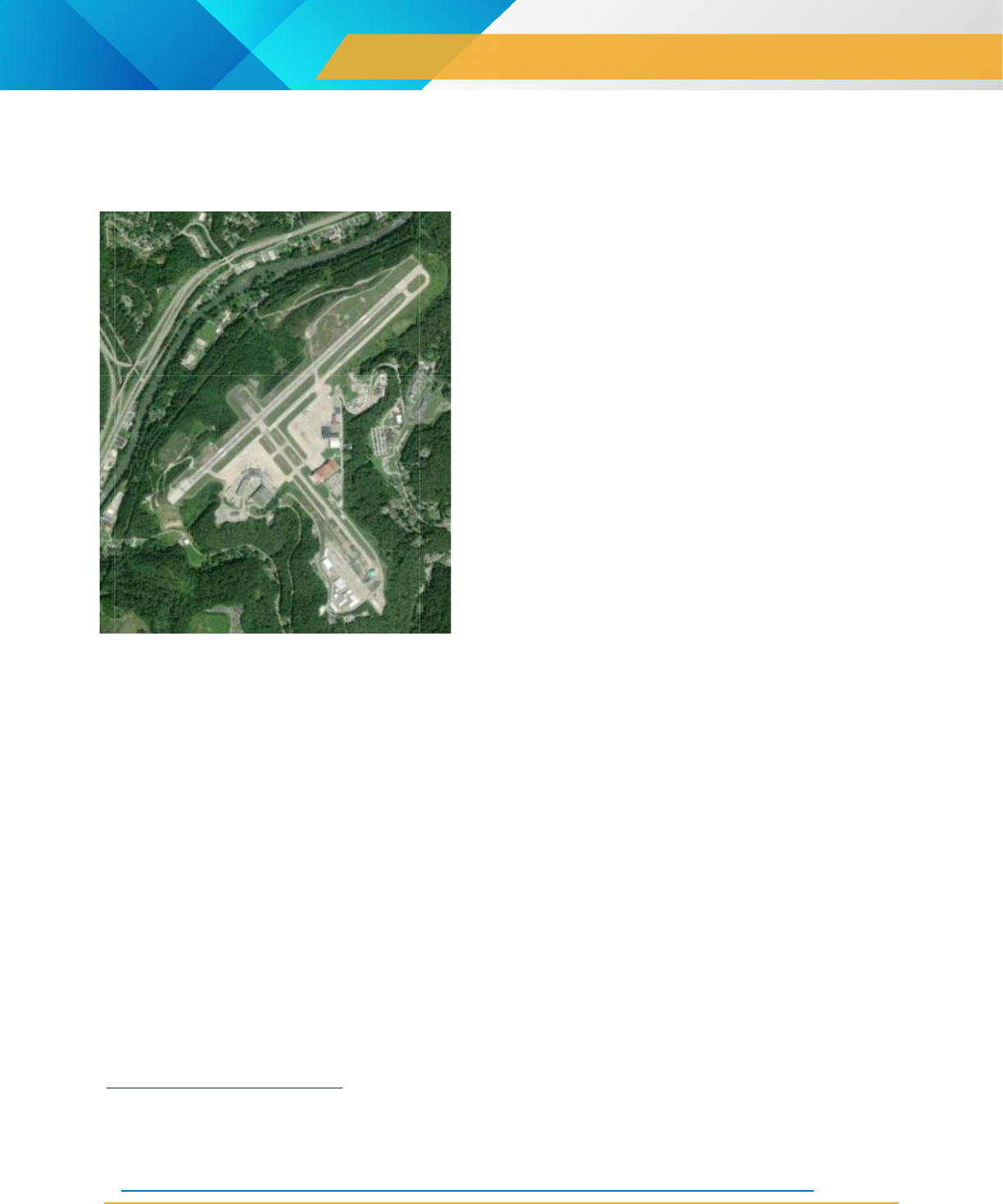
Air Cargo Profile
West Virginia Department of Transportation
13
West Virginia International Yeager Airport (CRW)
CRW is located approximately 2.5 miles northeast of
Charleston, West Virginia, and a range of U.S. carriers
operate a domestic route network from the airport. The
airport utilizes a single 6,715-foot runway running
northeast-southwest and occupies an area of 767 acres.
Although the airport lies besides I-77 and I-79, there are no
junctions which directly connect CRW to these interstates.
The only road access to the airport is the West Virginia
Route 114, running to Charleston. CRW processed five
tons of enplaned air freight and 219 tons of deplaned air
freight in 2021,
8
operated by PSA Airlines (operating on
behalf of American Airlines) via belly hold and ad hoc USA
Jet Airways operations with dedicated cargo aircraft.
CRW handled 149,000 departing passengers in 2021.
9
Services to the airport are provided by American Airlines (to
Charlotte and Washington DC National), Delta Air Lines (to
Atlanta), Spirit Airlines (to Orlando), and United Airlines (to
Chicago O’Hare), although Spirit Airlines announced in
March 2023 that it is to suspend services to CRW
beginning May 2023. Beginning in May 2023, Breeze
Airways began serving CRW with new nonstop flights to
Orlando, Florida (MCO) and Charleston, South Carolina
(CHS), with at least three additional destinations planned for the next two years.
10
It is anticipated that this
new service will include freight capacity and thereby provide mobility to each airport’s regional economy.
CRW was awarded FAA grants in September 2022 ($1 million for completion of an environmental impact
statement for a proposed runway safety area project), and March 2023 ($1 million to upgrade the terminal
building, including improvements to disability compliance and roof installation works).
The eighteen airports in West Virginia that did not report any air cargo activity in 2021 are shown in Table
2-2.
Table 2-2: Other West Virginia Airports
• Morgantown Municipal Airport (MGW)
• Mid-Ohio Valley Regional Airport (PKB)
• Eastern WEST VIRGINIA Regional Airport
(MRB)
• Mercer County Airport (BLF)
• Philippi/Barbour County Regional Airport (79D)
• Wyoming County Airport (Kee Field) (I16)
• Mason County Airport (3I2)
• Jackson County Airport (I18)
8
Mott MacDonald analysis of Bureau of Transportation Statistics, T-100 data
9
Mott MacDonald analysis of Bureau of Transportation Statistics, T-100 data
10
Breeze Airways to connect CRW to at least 5 new destinations - West Virginia International Yeager Airport
Source: Esri ArcGIS
Figure
2-6 West Virginia International
Yeager Airport (CRW)

Air Cargo Profile
West Virginia Department of Transportation
14
• Upshur County Regional Airport (W22)
• Elkins-Randolph County Airport (EKN)
• Fairmont Municipal Airport (4G7)
• Logan County Airport (6L4)
• Marshall County Airport (MPG)
• Summersville Airport (SXL)
• Braxton County Airport (48I)
• Wheeling Ohio County Airport (HLG)
• Appalachian Regional Airport (EBD)
• Grant County Airport (W99)
2.2 West Virginia Air Cargo Service Classification Types
Commercial air freight in West Virginia connects to other forms of transport. The transport mode used
depends on the operator of air freight as well as the facilities available at the destination. The following
section will provide an overview of the air freight types available in West Virginia, which often have specific
time of day and routing patterns.
2.2.1 Dedicated Air Cargo
Dedicated air cargo operators deliver cargo from the origin airport to the destination airport with an aircraft
that is dedicated to cargo transportation. Dedicated cargo aircraft can require special equipment to load
cargo onto and off the aircraft. They also require a cargo ramp to operate under normal circumstances.
In West Virginia, USA Jet Airlines is one of the air freight operators that provide freight services and utilizes
one McDonnell-Douglas MD-83 aircraft and six MD-88(SF) planes, operated as full freighter aircraft.
USA Jet Airlines operates on-demand air charter freighter services in North America. It is a U.S.-based
subsidiary of Ascent Global Logistics, providing logistic services as well as technical support to freight
management. USA Jet Airlines has a relatively small fleet, with seven MD-80F planes, two Boeing 727F
planes, and one DC-9F. In 2021, USA Jet Airlines handled three tons of cargo at CRW, which accounted for
60% of air cargo tonnage at that airport.
2.2.2 Integrator
An integrator is similar to a dedicated air cargo operator in that it owns a freighter aircraft fleet. However,
integrators take full custody of a package or delivery from pick up to drop off, so they also own their own
trucks and sorting centers. FedEx, United Parcel Services (UPS), and DHL are examples of integrators
operating in the U.S.
In West Virginia, FedEx is the largest cargo integrator that provides air freight services at various airports.
FedEx Cargo Centers are set up at HTS and BKW airports to process cargo that is to be transported
onwards by truck.
FedEx is one of the largest air cargo operators in the world and the largest that operates to West Virginia. It
has nearly 700 full cargo freighter in various sizes and ranges to suit a variety of operational needs, although
the largest type to serve West Virginia on a regular basis is the Boeing 757F, which can carry more than 80
tons of cargo and is a type for which HTS is a hub airport. In 2021, FedEx processed 3,654 tons of outbound
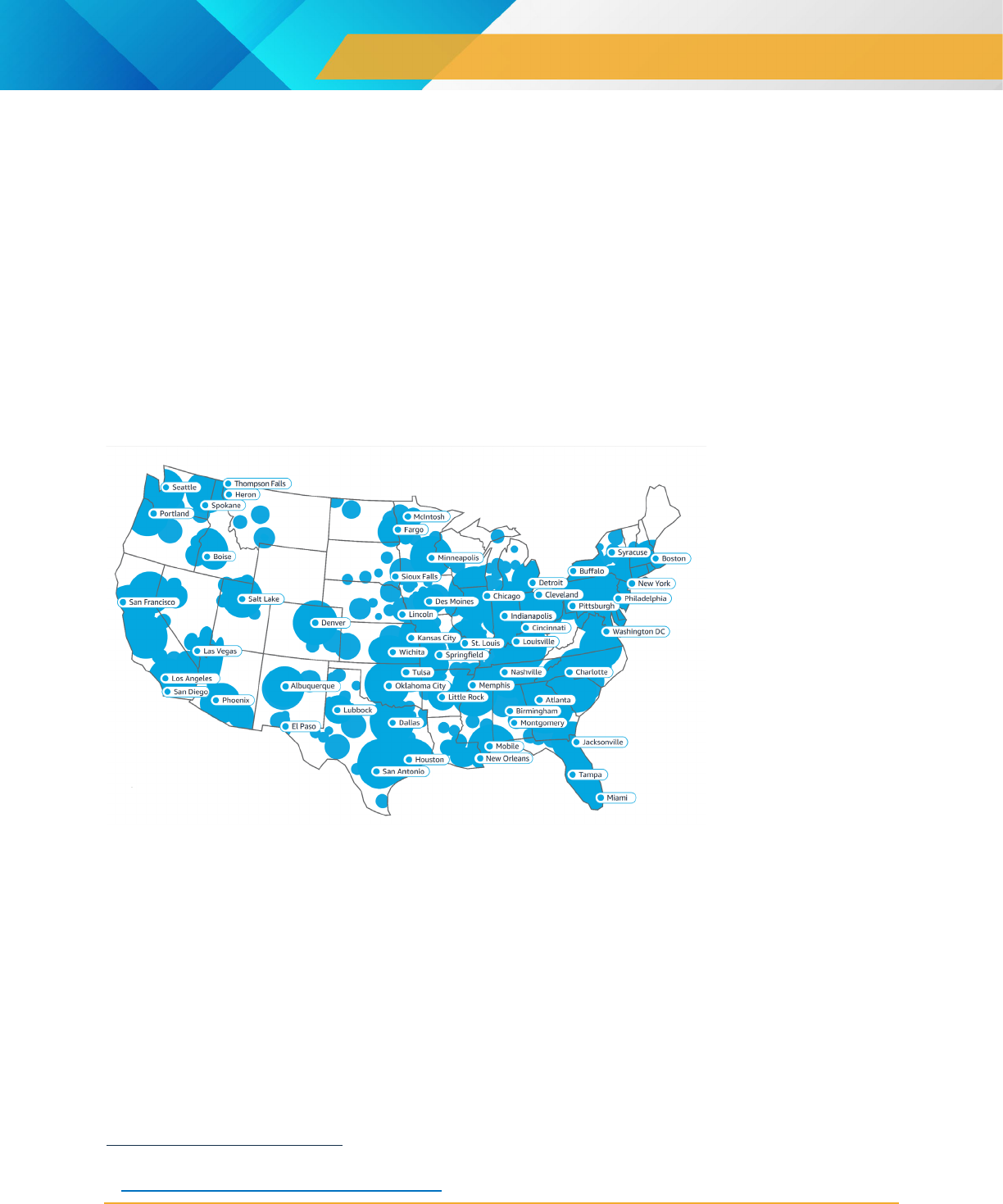
Air Cargo Profile
West Virginia Department of Transportation
15
enplaned air freight from HTS and BKW, which accounted for approximately 98% of outbound enplaned air
freight tonnage in West Virginia.
Atlas is another major global air freighter operator, with a fleet size of 88 aircraft in 2023, although as most of
the airports with cargo operations in West Virginia have runways shorter than 7,000 feet, as well as a
relatively small air freight market, the B737F is best suited to cargo operations in West Virginia. Atlas
operated at HTS during 2021 and processed 33 tons of outbound enplaned air freight.
Amazon could be considered both an integrator, as it owns its own freighter aircraft fleet, and dedicated air
cargo, in that its aircraft is dedicated to cargo transportation. Amazon generates its own freight cargo via its
e-commerce platform and provides freight solutions to third party clients.
11
Amazon’s freight coverage for
third party clients includes most major U.S. cities as shown in Figure 2-7 below.
Figure 2-7 Amazon Freight Coverage Map
Source: Amazon Freight
2.2.3 Belly Cargo
Belly cargo is carried in the holds of passenger aircraft. When passenger aircraft are operated, passenger
baggage is loaded on the lower deck of the aircraft. However, this seldom utilizes all the space in the lower
deck. The typical design of passenger aircraft allows the fitting of Unit Load Devices (ULDs) into the lower
compartment to carry belly cargo as well as passenger baggage.
Other airlines that transport air freight from West Virginia use the belly cargo compartment of passenger
aircraft. United Airlines, being one of the largest passenger aircraft operators in the U.S., handled a total of
21 tons of enplaned air freight from West Virginia in 2021 and was the sole operator of air cargo at HTS and
CKB. PSA Airlines is a subsidiary of American Airlines Group (AA), owning more than 130 CRJ jet aircraft. In
11
Amazon Freight: Shipping and Logistics Services

Air Cargo Profile
West Virginia Department of Transportation
16
2021, the airline handled two tons of outbound enplaned air freight at CRW in its passenger aircraft cargo
compartment, having a 40% share of the market at CRW. Piedmont Airlines is also a subsidiary of AA,
providing U.S. regional passenger services with more than 50 ERJ-145 airplanes. It transported one ton of
air cargo in 2021 at HTS, accounting for less than 1% of the cargo tonnage at the airport. It should be noted
that the cargo capacity in these CRJ and ERJ aircraft is exceptionally small. However, AA is phasing out
these aircraft to be replaced with larger Embraer E-175 jets which have larger hold capacity. When these
aircraft are deployed on these routes, it will present an opportunity to increase the freight activity to the
respective airports.
2.2.4 U.S. Mail
The United States Postal Service (USPS) is one of the world’s largest mail delivery services; however, it
does not operate any aircraft. Instead, the USPS contracts its airmail operations out to commercial
operators, including passenger carriers (although some aircraft historically were operated in a USPS livery,
these were aircraft operated under contract).
In the fiscal year 2022, the USPS increased its spending on surface transport (trucks) to move mail and
packages between facilities and shifted volume away from air. This is part of a plan to improve the USPS’s
financial position, with Postmaster General Louis De Joy noting that trucking capacity in the ‘middle mile’
network is underutilized,
12
and is likely to impact air carriers. The USPS was FedEx’s largest customer as of
May 2022 (FedEx carried USPS mail on domestic air routes), and FedEx stated that ‘A decision by the
USPS to terminate early or not renew its contract with FedEx Express for domestic services, which expires in
September 2024, would negatively impact our profitability’.
13
2.3 Other Air Cargo Gateways
Much of the air cargo moving through WV travels via truck to and from airports outside the state, including
Washington Dulles (IAD), Baltimore (BWI), Cincinnati (CVG) and others. Carriers using these airports include
USA Jet Airlines, FedEx, UPS, Delta Air Lines, and Air Transport International.
Washington Dulles (IAD):
Washington Dulles Airport is used by USA Jet Airlines
Baltimore (BWI)
Baltimore/Washington International Airport serves about twenty freight carrier companies including FedEx,
UPS, Delta Air Lines, American Airlines, British Airways, and ABX Air Inc.
Cincinnati/Northern Kentucky International Airport (CVG)
Cincinnati/Northern Kentucky airport is used by nearly thirty different freight carrier companies, including
FedEx, UPS, United Air Lines, Delta Air Lines, Air Transport International, Atlas Air Inc, and Amazon.
12
Supply Chain Dive, ‘US Postal Service spends more on ground transport as it shifts away from air cargo’, Mar 16, 2023
13
Supply Chain Dive, ‘US Postal Service spends more on ground transport as it shifts away from air cargo’, Mar 16, 2023
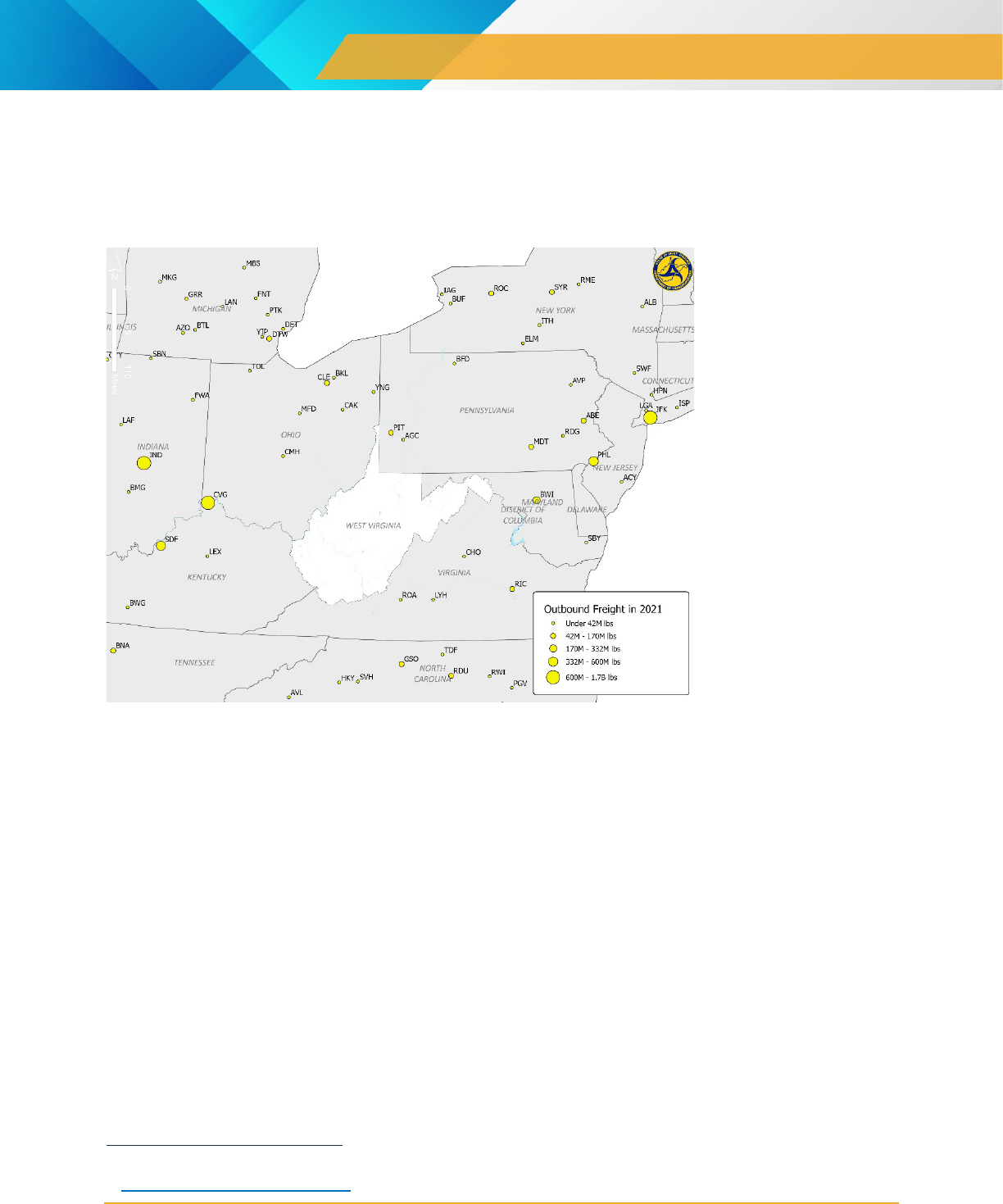
Air Cargo Profile
West Virginia Department of Transportation
17
Amazon has announced the upcoming development of its primary hub on the south side of CVG’s airfield.
The hub will include $1.5 billion of investments including over a hundred Prime Air cargo planes, construction
of three million square feet of buildings, and more than 2,000 additional jobs.
14
Figure 2-8 Freight Airports near West Virginia
Source: Bureau of Transportation Statistics, 2023
14
Amazon and CVG (cvgairport.com)

Air Cargo Profile
West Virginia Department of Transportation
18
3.0 AIR CARGO DEMAND
3.1 Total Air Freight Demand
Demand for freight transportation in West Virginia is driven by the state’s economy. Traditionally, energy and
manufacturing industries have been the key drivers West Virginia’s economy (coal is still the top commodity
by weight shipped to and from West Virginia); however, technology-based businesses are playing an
increasingly significant role. This shift from high-weight, low-value goods to lower-weight, high-value goods
increases the importance of air cargo as a freight mode in the state, as these industries are more likely to
ship and receive time-sensitive goods. Other economic trends, such as the rise of e-commerce, also play a
significant role in driving the demand for air cargo in West Virginia.
This section uses FHWA's Freight Analysis Framework (FAF) data to show the projected demand for air
cargo in West Virginia. Due to the nature of FAF data, these numbers and forecasts include both volumes of
goods that are trucked to and from airports outside of West Virginia in addition to goods that move through
airports within the state. Through traffic, i.e., traffic that does not begin or end its journey in West Virginia, is
not included.
Figure 3-1 shows the share of goods tonnage moving on each mode of in West Virginia from 2017 projected
to 2050. A large share of freight tonnage is transported to and from West Virginia by truck (45% in 2019).
Trucks are expected to continue to be the dominant mode through 2050, increasing their share to 57% by
2050. Other significant modes of freight transport from West Virginia are rail, pipelines, and water. Air
(including truck-air) freight contributed about 0.01% to the overall share of freight tonnage transported to and
from the state in 2019.
15
The FAF data indicates that a little over 31,700 tons of air (including truck-air) freight
arrived or departed West Virginia in 2019, and this is expected to increase to approximately 119,200 tons by
2050. Figure 3-2 presents the historic and forecast outbound air freight tonnage from West Virginia. While
the share of air freight tonnage is expected to remain at under 1% through 2050, volumes are expected to
increase by an average of 4% per annum between 2019 and 2050.
15
Freight Analysis Framework (FAF) data, accessed via the Bureau of Transportation Statistics, April 2023
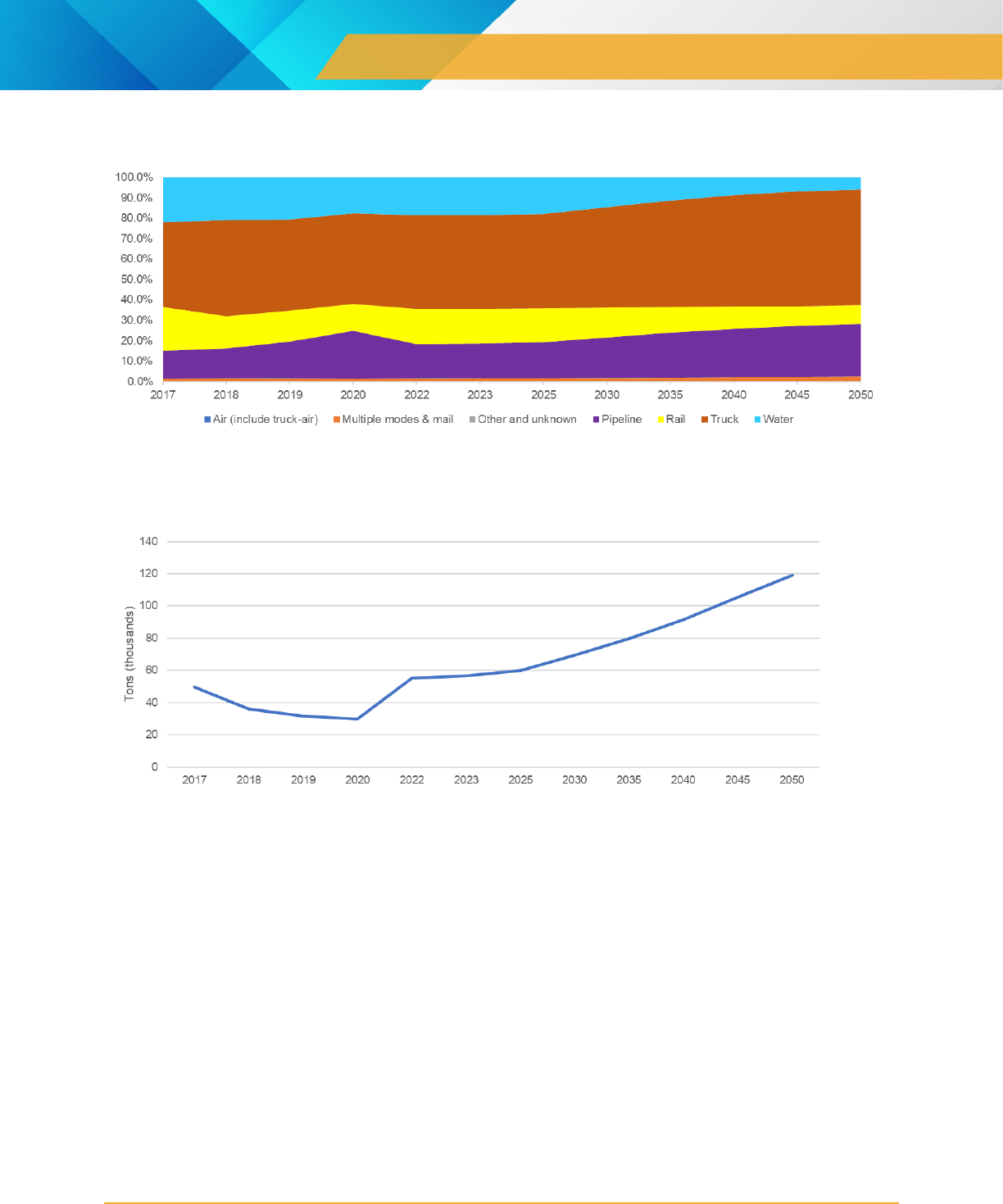
Air Cargo Profile
West Virginia Department of Transportation
19
Figure 3-1 Share of Two-Way Freight Transport Modes by Tonnage in West Virginia, 2017 Projected
through 2050
Source: Freight Analysis Framework (FAF), accessed via the Bureau of Transportation Statistics, April 2023
Figure 3-2 Two-Way Air Freight Tonnage in West Virginia, 2017 through 2050
Source: Freight Analysis Framework (FAF), accessed via the Bureau of Transportation Statistics, April 2023
Figure 3-3 shows the historic and forecast share of commodities transported to and from West Virginia by air
freight. Most of West Virginia’s air freight is expected to consist of mixed freight and plastic and rubber
exports.
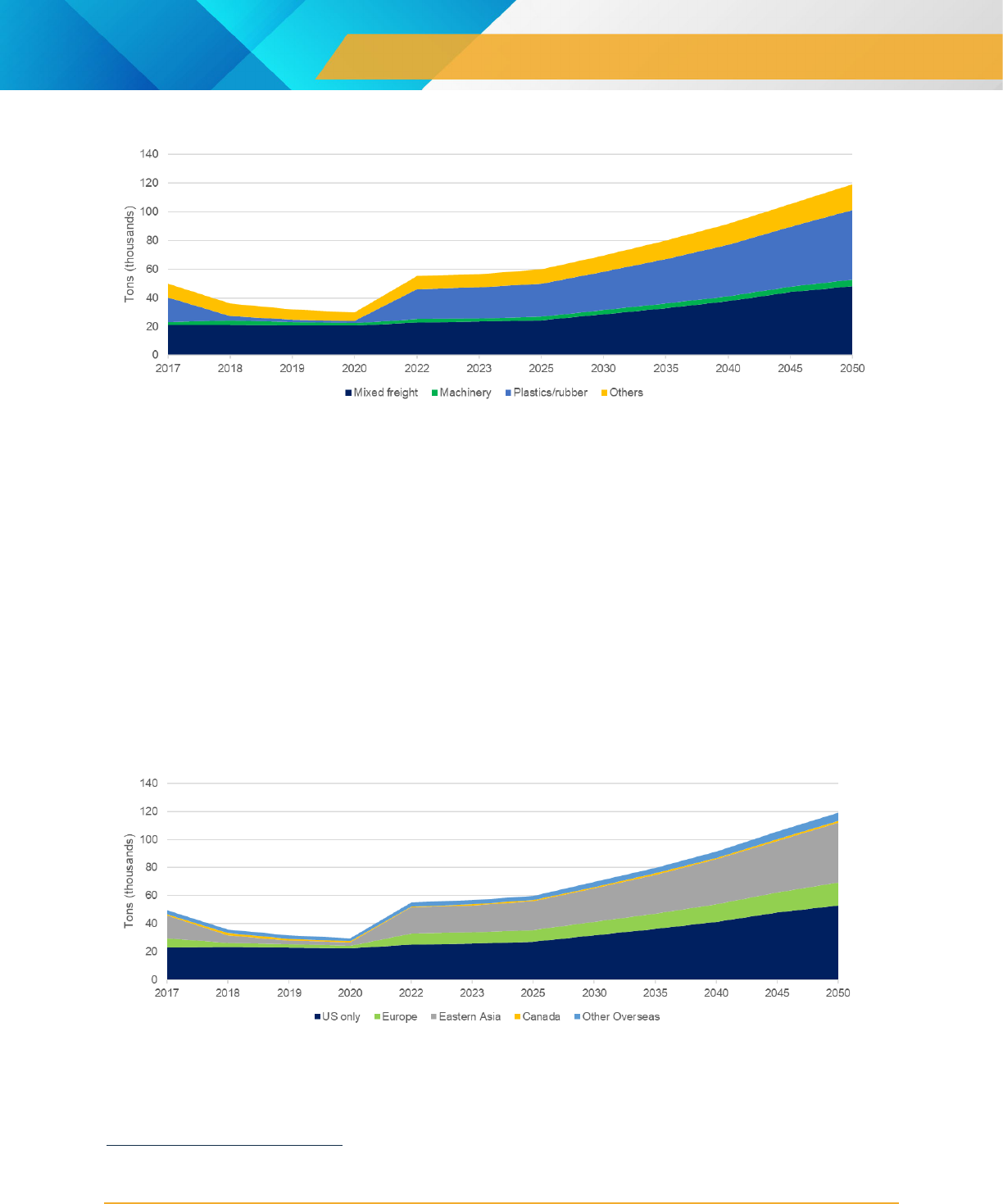
Air Cargo Profile
West Virginia Department of Transportation
20
Figure 3-3 Air Freight Commodities to and from West Virginia 2017 through 2050
Source: Freight Analysis Framework (FAF), accessed via the Bureau of Transportation Statistics, April 2023
Most of the air freight (over 90% according to FAF data in 2019) arriving into West Virginia is from U.S.
domestic origins, most notably Tennessee and this may be due to FedEx having a ‘super hub’ at Memphis
International Airport. It should be noted that the volume of outbound freight far exceeds the inbound,
suggesting that West Virginia is producing commodities which are being shipped worldwide much more than
they are receiving goods and services. Most of the air freight departing from West Virginia is ultimately
travelling to international destinations and this is expected to remain the case through 2050. Most freight
from West Virginia is destined for Eastern Asia (China was the largest importer of natural rubber in 2021
16
)
and Europe. Eastern Asia is expected to be the ultimate destination for over 66% of air freight from West
Virginia from 2022 through 2050. Figure 3-4 shows the air freight arriving into and departing from West
Virginia, with the most significant increase shown to Eastern Asia.
Figure 3-4 Ultimate Origins and Destinations of Air Freight to and from West Virginia 2017
through 2050
Source: Freight Analysis Framework (FAF), accessed via the Bureau of Transportation Statistics, April 2023
16
Statistica.com
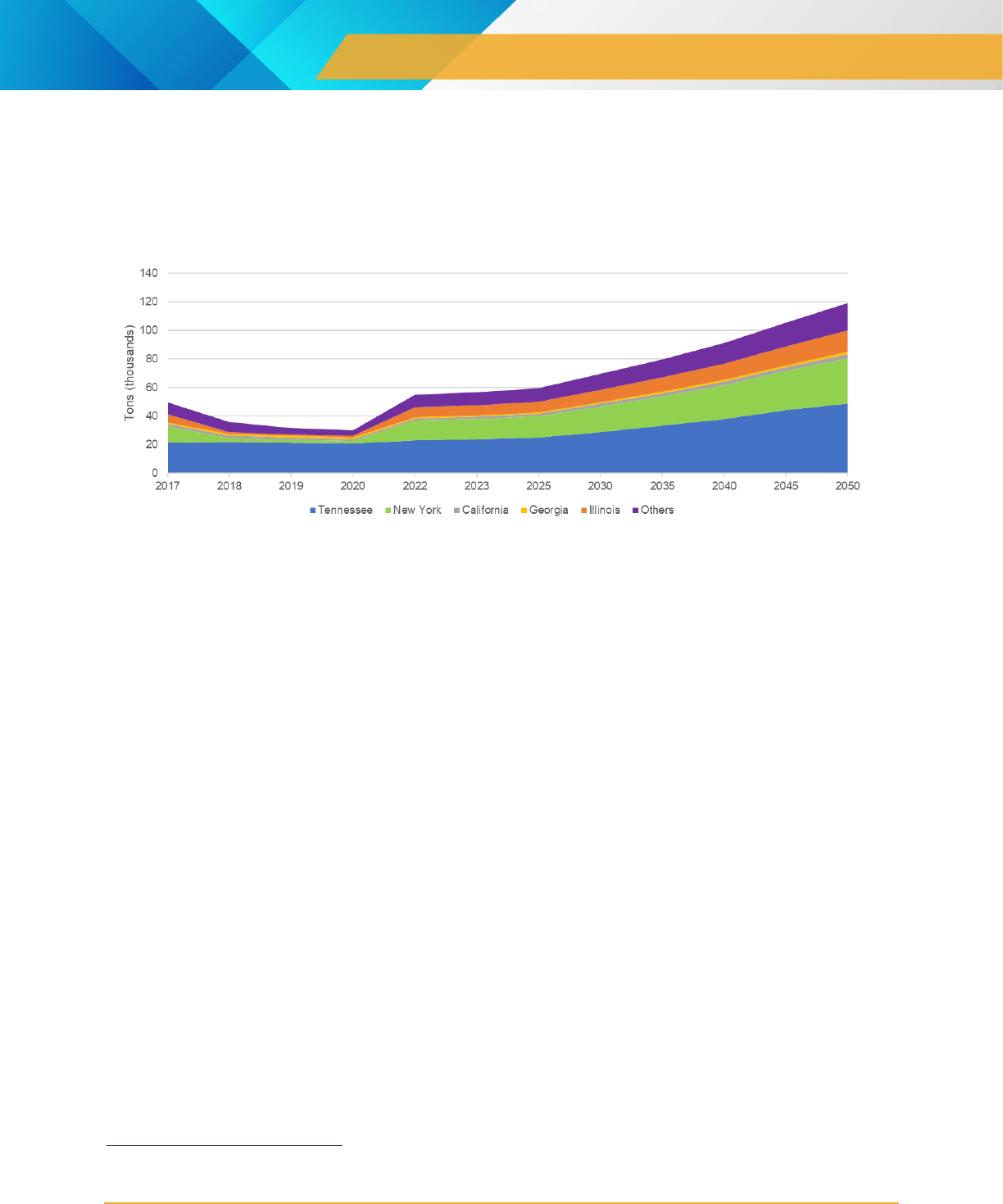
Air Cargo Profile
West Virginia Department of Transportation
21
As West Virginia’s airports handle no direct flights to overseas destinations, the air freight from West Virginia
bound for overseas destinations transits through other U.S. airports. Figure 3-5 shows that most of the air
freight to and from West Virginia travels via Tennessee and New York (over 70% in 2019).
Figure 3-5 Domestic Origins and Destinations (U.S. States) of Air Freight to and from West Virginia
2017 through 2050
Source: Freight Analysis Framework (FAF), accessed via the Bureau of Transportation Statistics, April 2023
Florida has also been one of the main domestic transiting points for air freight, although there may well be
the emergence of other domestic transiting points as airlines offer new service to West Virginia, opening up
competitive alternative routes. With respect to international air freight, it is likely that these commodities and
packages transit ‘hub’ airports located within these states:
• New York: New York’s John F Kennedy International Airport (JFK) is one of the U.S.’s major airports and
handles many intercontinental flights to countries in Eastern Asia and Europe, as well as Canada, South
America, the Caribbean, the Middle East, and Africa.
• Illinois: The busiest airport in Illinois is Chicago’s O’Hare International. O’Hare is a major North American
hub, and handles flights to Europe, Asia, Canada, South America, and the Middle East.
• Pennsylvania: Pennsylvania’s busiest airports are Philadelphia International and Pittsburgh International.
These airports do not serve the range of intercontinental destinations that JFK or O’Hare do, however
Canada, the Caribbean, Europe, and the Middle East can be reached directly from Philadelphia, while
Canada and some European destinations (notably the UK) can be reached directly from Pittsburgh.
17
3.2 Future of Aviation Trends
This section will cover aviation trends that have the potential to impact air cargo and related activities in West
Virginia. Key trends examined include aircraft and airport technology, economic trends, Unmanned Aerial
Systems (UAS), aviation security, and responses to the COVID-19 pandemic.
17
Mott MacDonald analysis of SRS Schedules Analyser data, accessed April 2023
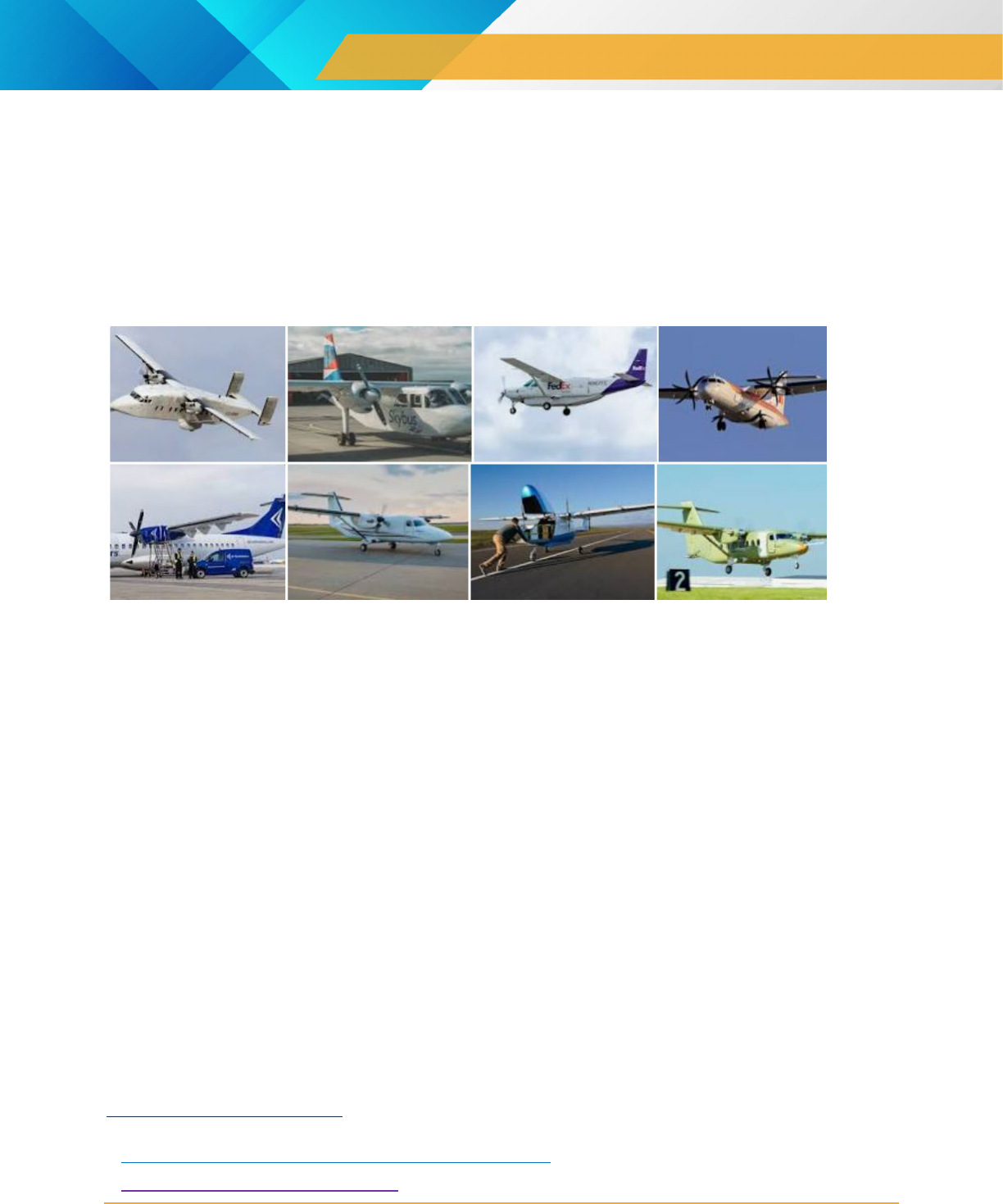
Air Cargo Profile
West Virginia Department of Transportation
22
3.2.1 Aircraft and Airport Technology
Aviation is an ever-evolving industry, with significant technological changes over the last 20-30 years.
Passenger airlines have been streamlining their service and reducing service to smaller destinations while
also replacing regional jets serving up to 50 passengers with larger 76-100-seat aircraft. This trend towards
larger aircraft has mixed impacts on air cargo, as larger aircraft have potentially more available belly space
for cargo, however the reduced service to smaller airports means fewer potential connections.
Many passenger aircraft are also converted to freighter aircraft at the end of their passenger-carrying life.
Aircraft such as the Boeing 757 and Boeing 767, McDonnall-Douglas MD-80/90, Saab 340, Aerospatiale
ATR-42/72 and Cessna Caravans, for example, are increasingly being converted to freighters for use in
carrying goods for both air cargo and integrated carriers.
A drive towards efficiency and reduction in greenhouse gas emissions is driving increasing efficiency in
aircraft design and fuel consumption. New fuel sources for aircraft, including low-emission diesel, hydrogen,
and electric-batteries, and being rolled out at an acerated rate. As severe weather and climate change
continue to impact our infrastructure, resiliency and energy efficiency are of growing importance to airport
infrastructure, from runways to cargo buildings. Airport buildings, including cargo-handling facilities, are also
opportunities for human-focused improvements, such as lighting, ventilation, water-use, aesthetics, waste
disposal, and other factors which can improve working conditions as well as building efficiency. Finnair’s new
COOL Nordic Cargo Hub at Helsinki airport includes solar panels providing 10% of the terminal’s energy, an
automated storage area with no lighting requirements, and automation and processes that reduce transport
time, vehicle idling, and waste management and maintenance trips.
18
3.2.2 Economic Trends
As cited in the 2020 West Virginia Aviation Economic Impact Study,
19
the existing aerospace industry in the
state supports 4,000 jobs, $201 million in payroll, and has a total economic impact of $1.325 billion as of
2019. By leveraging its aviation focused industries and those that use air cargo, West Virginia can continue
to grow and diversify its economy. Companies already operating within West Virginia include Pratt and
Whitney Engine Services and Helicopter Powerline Services. Aviation-focused and air cargo industries can
18
What does green air cargo terminal design look like? (finnair.com)
19
WV AEIS Complete Technical Report_.pdf

Air Cargo Profile
West Virginia Department of Transportation
23
provide an attractor for both vertical and horizontal supply chains, which facilitates the state’s efforts to
attract other industries.
Worldwide, e-commerce has been one of the driving forces of a shifting economy over the last decade. The
effects of e-commerce were multiplied during the COVID-19 pandemic when electronic purchasing of goods
and services grew at an accelerated pace and replaced traditional commercial activities for both businesses
and consumers. Amazon and other suppliers have expanded exponentially, setting up warehouses and
distribution centers across the globe and country. Amazon Air, a cargo airline exclusively devoted to Amazon
fulfillment, launched in 2015 and offers direct service to many airports.
20
3.2.3 Advanced Air Mobility, Urban Air Mobility, and Unmanned Aircraft Systems
Advanced Air Mobility (AAM) is the integration of highly automated aircraft into the National Airspace
System.
21
Urban Air Mobility (UAM) is one concept of this, referring to the movement of passengers or cargo
via highly automated aircraft within urban areas.
22
Both concepts are managed by the FAA and are under
exploration and development.
Some operators are anticipating that AAM and UAM operations for cargo could commence as early as 2024,
with passenger vehicles to be developed in parallel, but operations likely to start sometime after 2026.
23
The initial stage length anticipated for these
operations would be up to 200 miles at most, with
small loads. These vehicles will be able to serve
remote communities much faster than existing
modes of transport. Some of the lighter and smaller
freight may switch to this mode, resulting in a
potential shift in the modal split for freight, particularly
as the speed at which this mode can operate may
well be faster than by truck or rail.
Unmanned Aircraft Systems (UAS) refers to varying
types of drone aircraft. UAS may also be a tool
employed in the future within cargo warehouses to pick goods, identify lost cargo and/or perform other
functions. Both processes and infrastructure may change over coming years to respond to increased robotics
and automation throughout the cargo handling supply chain.
3.2.4 Aviation Safety and Security
The FAA is the primary agency responsible for all aspects of aviation safety, and regulates both passenger
and air cargo traffic, as well as airports. Generally, air cargo is a safe mode of transportation, as is the entire
20
Amazon in talks to lease Boeing jets to launch its own air-cargo business | The Seattle Times
21
Advanced Air Mobility (faa.gov)
22
Urban Air Mobility (UAM) Concept of Operations 2.0_0.pdf (faa.gov)
23
HAI_Advanced_Air_Mobility_Report_04-07-2023.pdf (rotor.org)

Air Cargo Profile
West Virginia Department of Transportation
24
aviation industry.
24
The International Civil Aviation Organization (ICAO) tracks global aviation safety and
reported a 9.8% decrease from 2.14 accidents per million departures in 2020 to 1.93 accidents per million
departures in 2021.
25
Of growing concern in recent years is the increase in cargo theft across the transportation supply chain. The
supply chain that air cargo incurs from origin to destination is subject to numerous risks including staffing
shortages and cargo theft.
26
Regulators and industry are working together to further secure the supply chain
while protecting the shipment and transfer of goods and services in support of global and local economies.
3.2.5 Response to the COVID-19 Pandemic
The aviation industry was significantly impacted by the COVID-19 pandemic. While passenger and some
cargo demand waned precipitously, other markets grew quickly. The aviation industry was tapped to respond
to growing demand for food, supplies, and manufacturing components, many of which would have previously
traveled by ship, rail, or truck, but due to the time and market constraints, became a market for air cargo.
Existing fleets were adapted to accommodate huge increases in demand, while the demand in some markets
faded as the crisis became less acute, others remained for the long haul.
24
Cargo Safety | Federal Aviation Administration (faa.gov)
25
ICAO_SR_2022.pdf
26
From the Magazine | Mitigating Supply Chain Risks In 2023 - Logistics Insider

Air Cargo Profile
West Virginia Department of Transportation
25
4.0 CONDITION AND PERFORMANCE
Airport condition and performance are largely dependent on their roadway connectivity and operating
capacity.
27
The following sections review the roadway networks surrounding West Virginia’s main freight
airports and future trends for the capacity of each airport.
4.1 Road Network Access
Road network around the airports is essential to efficient operation, especially for freight operations and truck
access. The WVDOT Aeronautics Commission works directly with airports and the FAA for projects funded
through Airport Improvement Program (AIP) funds for 'inside the gate' improvements, including roadway
intra-airport improvements.
28
WVDOT is also concerned about access into and out of airports, working to
provide truck access via roadways of appropriate condition and capacity.
4.1.1 BKW
BKW is 1.5 mile away from the entrance of I-64 highway connected by a single lane two-way minor road,
further connected to U.S. 19 to the north and I-64 and I-77 to northwest and southeast. There is a small
settlement and an academy near the entrance of the I-64 highway which might cause minor congestion.
27
Texas Transportation Institute Guidebook on Landside Freight Access to Airports, February 2011.
http://tti.tamu.edu/documents/0-6265-P1.pdf
28
2022 Airport Improvement Program (AIP) Grants | Federal Aviation Administration (faa.gov)
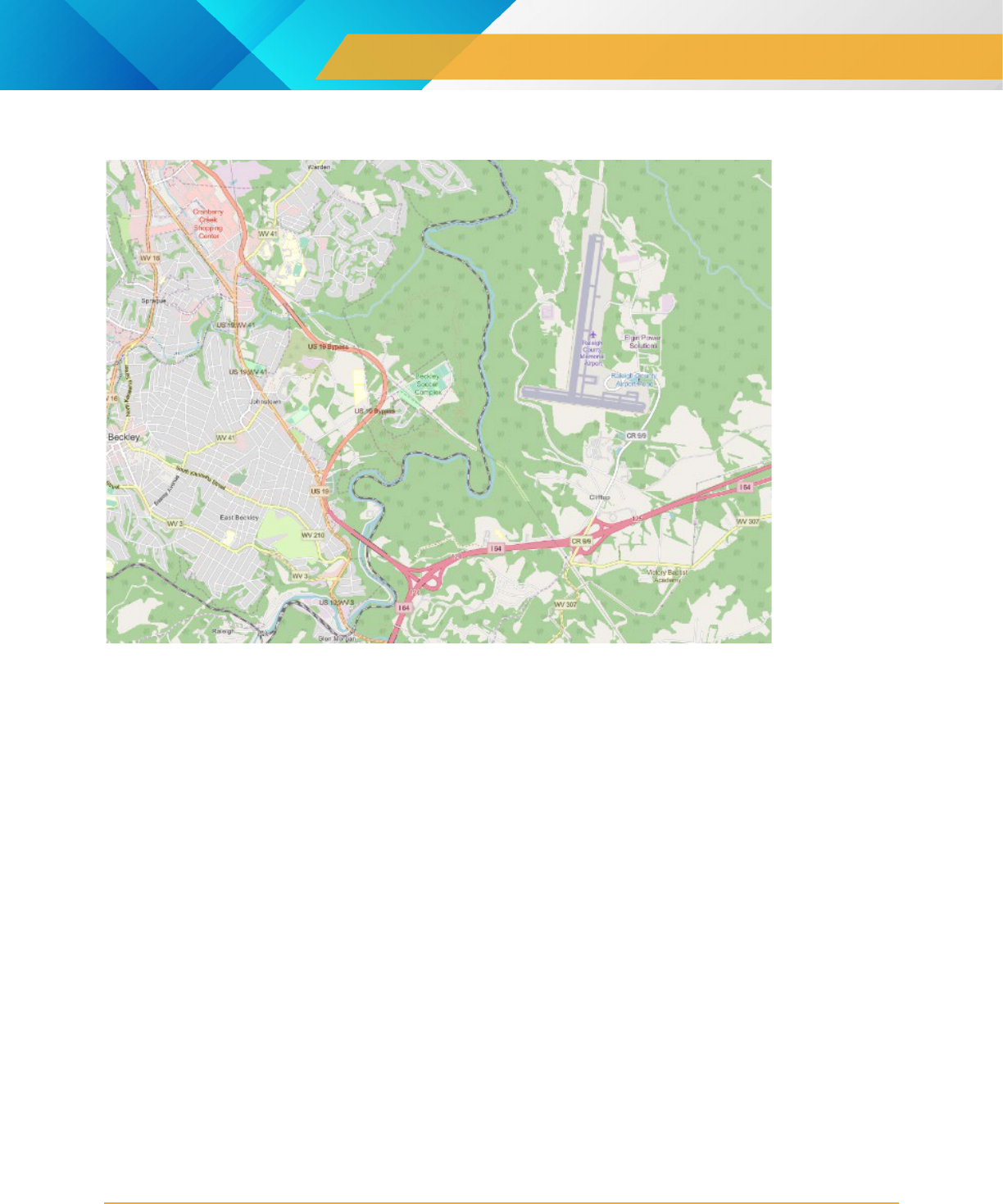
Air Cargo Profile
West Virginia Department of Transportation
26
Figure 4-1 BKW Airport
Source: OpenStreetMap
4.1.2 CKB
CKB is directly next to the U.S. 50 and connects to I-79, which makes the airport accessible. However, the
airport is surrounded by a large number of settlements that are also connected to U.S. 50, which may lead to
congestion before the truck can get onto I-79 highway that is isolated with local traffic.
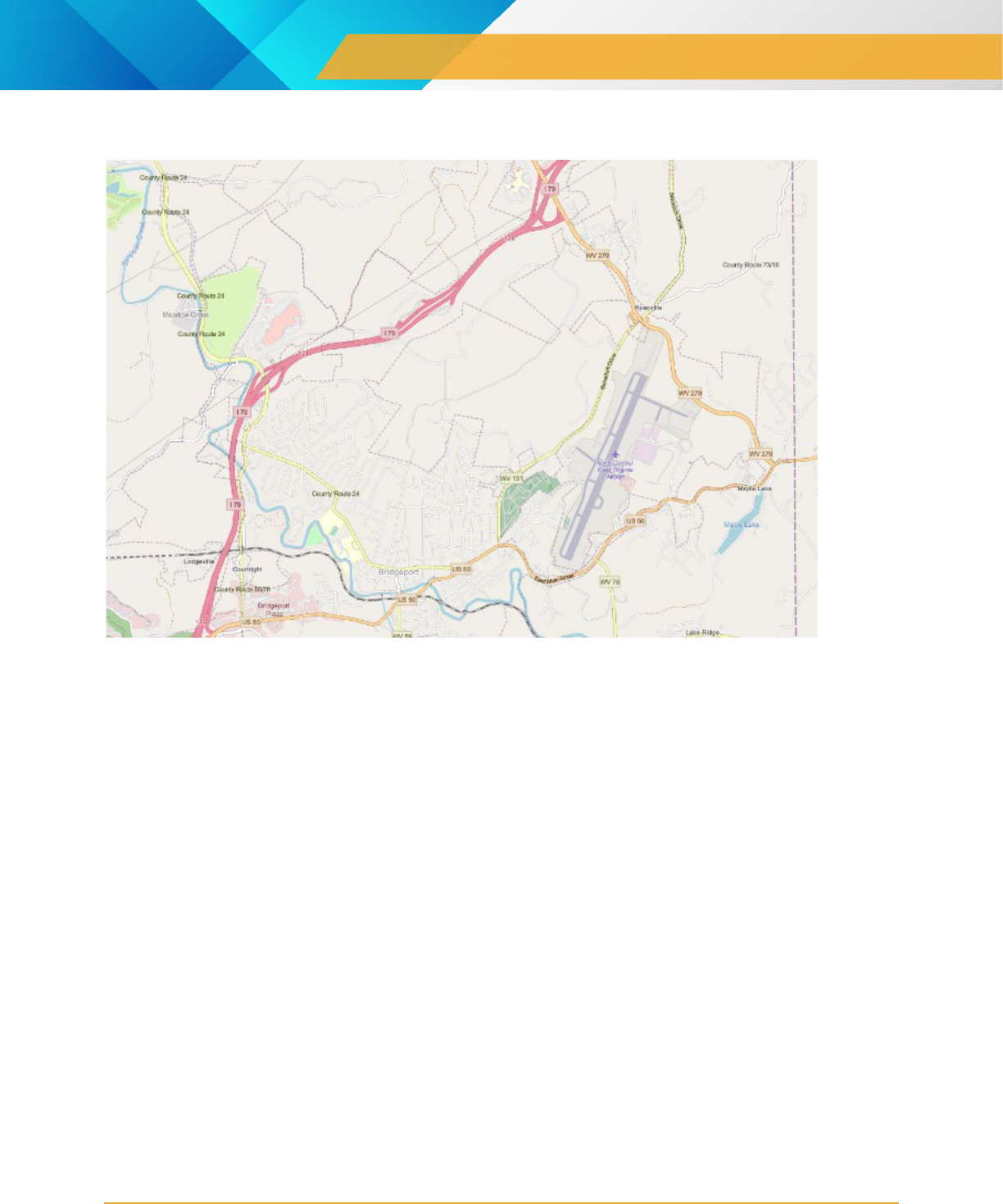
Air Cargo Profile
West Virginia Department of Transportation
27
Figure 4-2 CKB Airport
Source: OpenStreetMap
4.1.3 LWB
LWB is easily accessible from U.S. 219 highway with the airport major access road directly connected to it in
less than 0.5-mile distance. The U.S. 219 highway is then connected to I-64 and U.S. 60 in the south. There
are a few settlements on U.S. 219 before reaching the junction to I-64, which may cause minor traffic
congestion to the area and delay ground access to the airport.

Air Cargo Profile
West Virginia Department of Transportation
28
Figure 4-3 LWB Airport
Source: OpenStreetMap
4.1.4 CRW
CRW is relatively less accessible by ground transport as it is only connected WV-114. It is separated from
I-77 and I-79 by Elk River, with no bridge connections across the river. All ground transport freight
connection relies on WV-114, which connects to I-64 and I-77 three miles southwest of the airport. This
creates a bottleneck along WV-114, which is subject to disruption by local Charleston traffic.

Air Cargo Profile
West Virginia Department of Transportation
29
Figure 4-4 CRW Airport
Source: OpenStreetMap
4.1.5 HTS
At HTS, the airport is connected with a two-mile-long single lane two-way road that is then connected to
U.S. 52, U.S. 23 and I-64. Truck access to the airport is efficient, as the airport is directly connected to the
highway without passing through industrial or residential neighborhoods. However, if truck traffic increases,
WVDOT should continue to monitor the condition and safety of the infrastructure, including lanes and
shoulders.
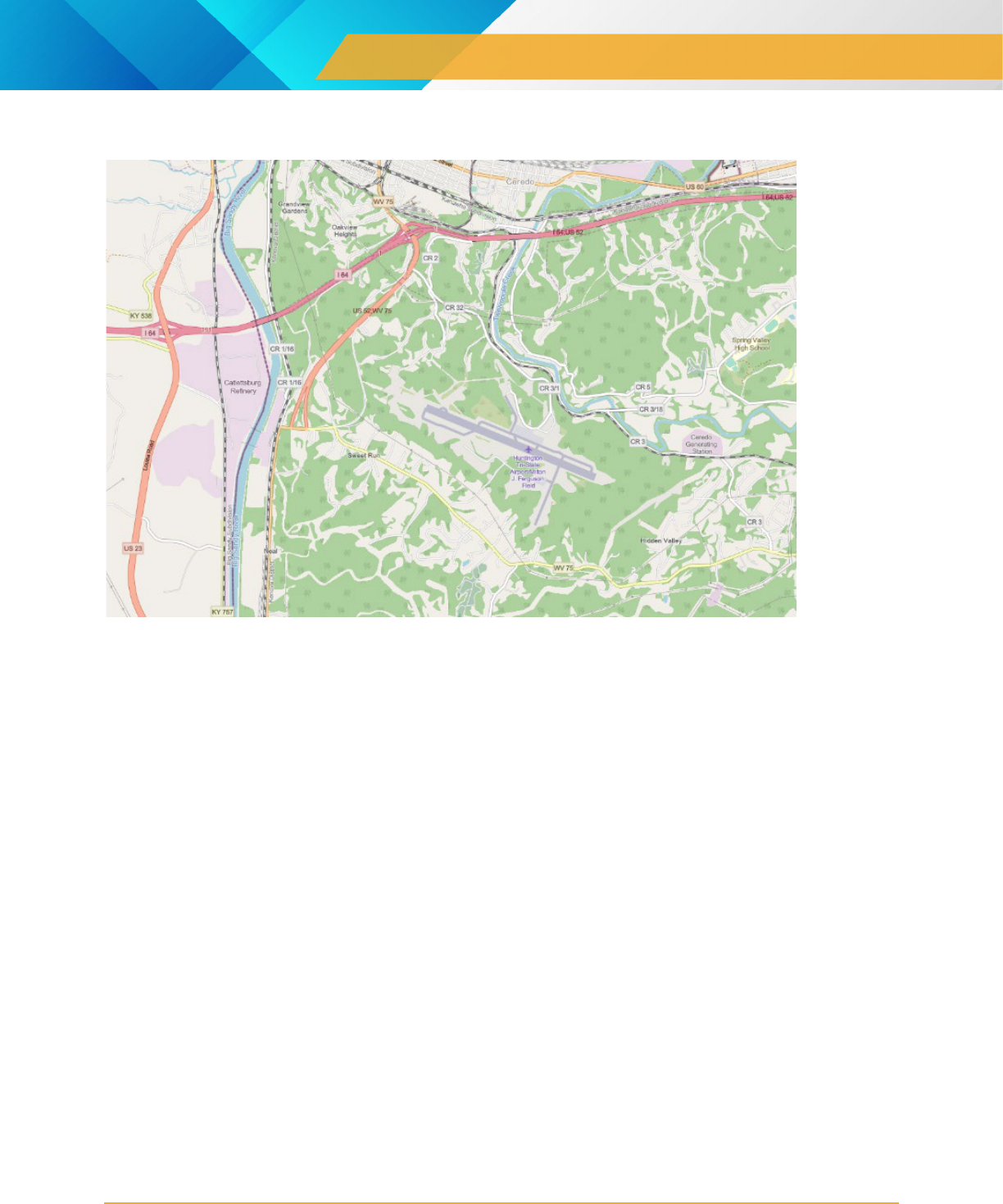
Air Cargo Profile
West Virginia Department of Transportation
30
Figure 4-5 HKS Airport
Source: OpenStreetMap
4.2 Capacity
West Virginia airports typically have enough capacity on the airfield, runways, and ramps to handle current
and future air cargo demand. As air cargo demand grows, terminals, processing facilities and roadway
infrastructure will be the first constraints to growth in air cargo services at West Virginia airports.
WVDOT will remain in contact with the airport operations and handlers locally to establish whether additional
processing facilities or landside/airport-specific warehouses are required to accommodate growth in demand
and whether land has been safeguarded for said growth.
4.3 Conclusions
As discussed, the aviation industry provides essential links to both rural communities within the state as well
as international access to send and receive goods and services globally. It is imperative for the economic
success of the state to maintain these services.
WVDOT should regularly communicate (monthly or quarterly) with the local agencies and airports to have an
up to date understanding of the movement of air freight, and how this is changing/evolving over time. There
may be some significant trigger points which the local agencies will identify and be able to share with
WVDOT to support the development of air freight. In addition, WVDOT should focus on maintaining a full
understanding of the industries most likely to rely on air to transport their cargo, such as health care
(biomedical goods), retail trade, natural resource extraction, transportation and warehousing, and

Air Cargo Profile
West Virginia Department of Transportation
31
construction. By identifying and understanding these industries, WVDOT will maintain an ability to assess
and predict their impacts on the West Virginia infrastructure and economy as a whole.
Finally, West Virginia is in close proximity to major air cargo centers including Columbus OH, Charlotte NC,
and Dulles VA. Ensuring efficient roadway access to these facilities is critical for meeting freight demands
and supporting the local economy.
